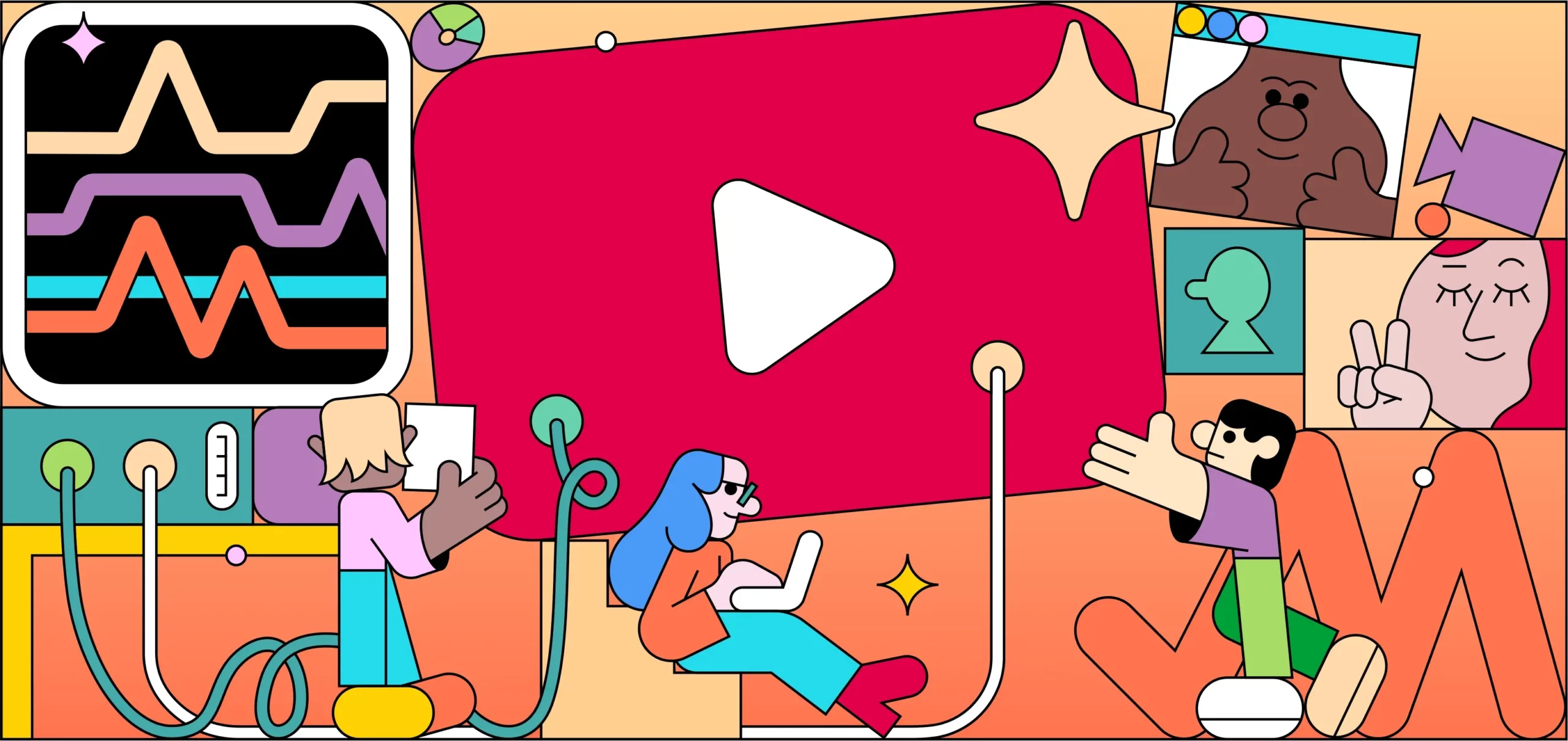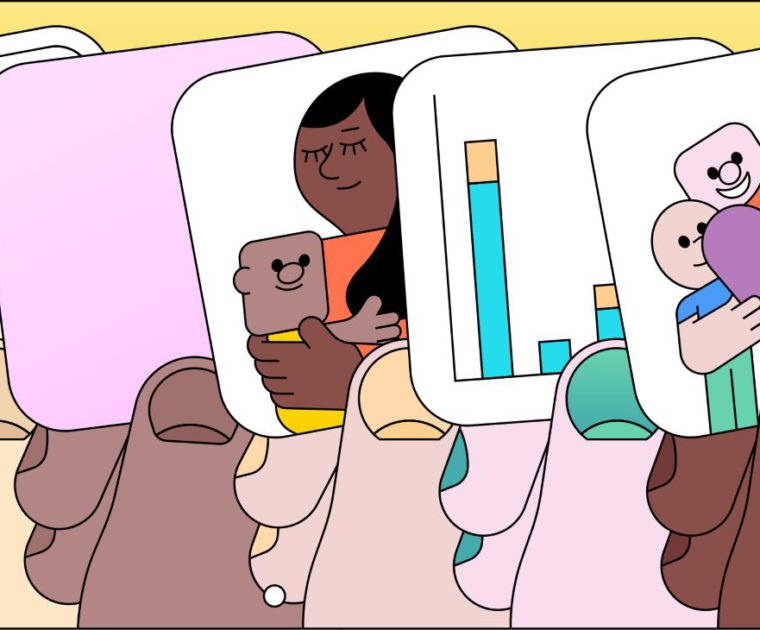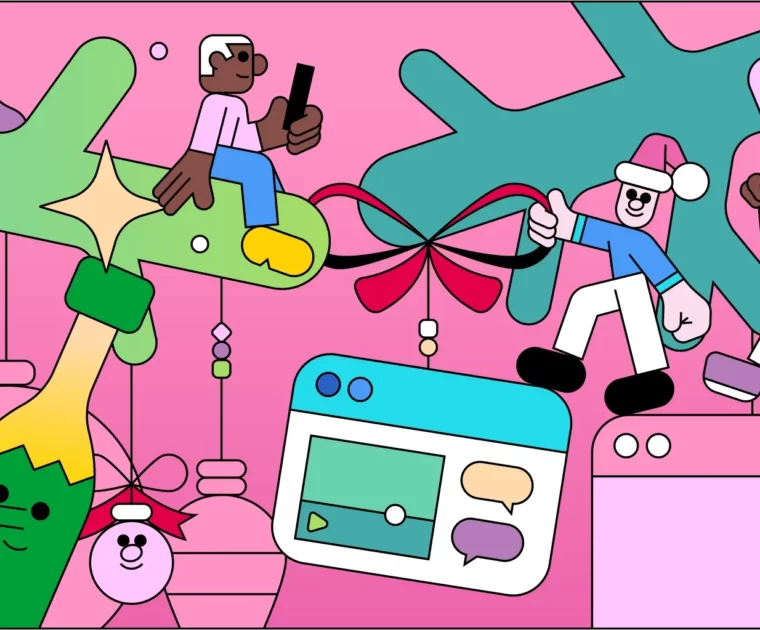A few years ago, the pandemic fundamentally changed the way most of us YouTube. The YouTube statistics don’t lie. It went from being everybody’s favorite video app to being a bonafide social media platform that people were using to engage in synchronized activities, attend worship services, and fulfill some of their entertainment needs.
Since then, other significant changes have happened on and around YouTube. Communities are thriving on the platform. Short-form video’s become a thing. Super long-form video? Also a thing. So, we’ve been keeping an eye on YouTube because it’s constantly changing, and marketers have to make a conscientious effort now to stay up to date with what’s happening on the platform. So, we’ve got YouTube statistics for you.
In this post, we’ve cataloged a list of YouTube stats that will help you understand all the basics about everybody’s favorite platform — how many folks are on the platform, who’s on it, how long they’re spending on the app, and what they’re doing while they’re there. We cover that, and a lot more in this post of the 2025 YouTube statistics, demographics, and usage data. Woot! Woot!!
Essential YouTube Statistics for 2025 Marketing Pushes
#1 YouTube has about 2.5 billion monthly users.
YouTube is the OG of video content platforms. Launched back in 2005 (on Valentine’s Day), YouTube now has over 2.49 billion unique users every month. YouTube is the second most popular social media platform after Facebook. To put that in perspective, there are 5.3 billion people on the internet, and 47 percent of them are using YouTube. That is A LOT of people.
#2 Roughly 90% of YouTubers are outside the U.S.
Only about 10 percent of YouTube users are in the United States. Still, US-based users represent the second largest audience, after India, where 18.5 percent of YouTubers (462 million people) reside. The platform’s available in 100 countries and in 80 languages.
#3 YouTube is the 2nd most-visited website in existence.
Right? No surprise there. YouTube is the second most visited website in existence after Google AND the second largest search engine in the world… also after Google.
#4 A billion hours of UGC and branded content are watched on the platform daily.
And that’s not even hyperbole! The range of content across YouTube is phenomenal, namely because it’s all user-generated content. Over a billion hours of video are watched every day on the platform, and you can find videos on a crazy range of topics from…
…. Learning how to boil an egg so it’s easy to peel
…. To getting a behind-the-scenes look at a movie you don’t want to admit you firggin’ love (Shut-up! You’re crying!).
… Or listening to the munching sounds of a guy who’s gotten kinda famous for eating on camera
… Me watching my kids watch other kids play games with their parents
… Or kids watching grownups play with dolls.
#5 YouTube reaches more young adults than all the TV networks combined.
On mobile alone a good look at YouTube statistics reveals that the platform reaches more viewers between the ages of 18 and 34 years old than any of the TV networks. In part, because… 👇🏽
#6 About 1 in every 15 YouTubers is watching the channel on a TV.
That’s right. On their big screens. Though 3 in 4 YouTubers access the app from their mobile devices (even when they’re at home), YouTube has 150 million connected TV (CTV) viewers in the U.S.
#7 YouTube gets the larges share of CTV watchers
Fully 26% of the time Americans spend watching TV is spent watchign YouTube videos. Comparably, 21% of CTV viewing hours are spent watching Netflix, followed by 12% spent watching Hulu, and 8% spent watching Amazon Prime Video.

#7 Most Americans ages 5 and up watch videos on YouTube.
Seriously, if I’m not on there goofing off or using The Huberman Lab as the soothing white noise that blankets my day, my 1st grader is watching The Fun Squad and my 3rd grader is obsessing over episodes of Mr. Beast. And we’re the norm.
In truth, YouTube usage stats confirm that YouTube is unanimously the MOST popular social media app when you take all the age groups into account. The top preferred or top used app changes from demographic to demographic. For instance, young adult men between the ages of 25 and 44 prefer Facebook, while women of the same age lean more toward Instagram (for 25 to 34-year-old women) and WhatsApp (for women 35 to 44 years old). But YouTube is the one app that all generations use just about daily.
According to Statista:
- 77% of US internet users 15 to 35 years old watch YouTube
- 73% of 36 to 45-year-olds watch YouTube
- 70% of 46 to 55-year-olds watch YouTube
- 67% of those 56 and older watch YouTube, and
- 80% of parents say their children under 11 watch YouTube
So, your audience is probably on the platform.
.
YouTube Trends: Video Content Consumption
#9 40% of adults describe themselves as video content creators.
This is one of my favorite YouTube trends because it signals an important shift in both who is creating video and how video is being created. Similarly, four in ten YouTube users between the ages of 18 and 44 would consider themselves content creators. That’s not insignificant! The Future of Creativity: Creators in the Creator Economy, a study published by Adobe, reports that there are roughly 303 million people in the world who identify as content creators — 165 million of whom joined the creator economy since 2020.
#10 More than 500 hours of content are uploaded to YouTube every single minute.
According to the 2023 YouTube Trends Report, 82 percent of people online (18 to 44 years old) say they’ve posted video content to one of the major video platforms (YouTube, TikTok, Instagram Stories, Snapchat). What this means is that content creation is becoming the norm, not just limited to a select few content creators who do it for a living.
Technology, cool YouTube features, creative filters, and generative AI are really pushing content creation to the next level, and in so doing, making video creation a more easily accessible and widely used form of expression.
#11 87% of adults are watching at least 4 content formats on YouTube.
Shorts, long-form video, podcasts, livestreams — most adults are grabbing content from YouTube in whatever way they see fit. And that’s a good thing. And with 18 to 24 year-olds, they’ve come to expect it with 67 percent of Gen Zers saying they like when their favorite creators create content in multiple formats.
#12 YouTube Shorts are now racking in more than 70 billion views every day.
YouTube’s short-form video app first rolled out in India after the Indian government banned TikTok back in 2020. Shorts arrived in the US a few months later in the spring of 2021, and has since grown exponentially. From 2022 to the end of 2023, daily views on the app grew from 1.5 billion to 70 billion views a day. The app now has 2 billion logged in users every month. And the best part — no one’s had to complain about their YouTube feed being inundated with Shorts — YouTube just kinda went with the flow and users got a chance to discover Shorts on their own. Very cool.
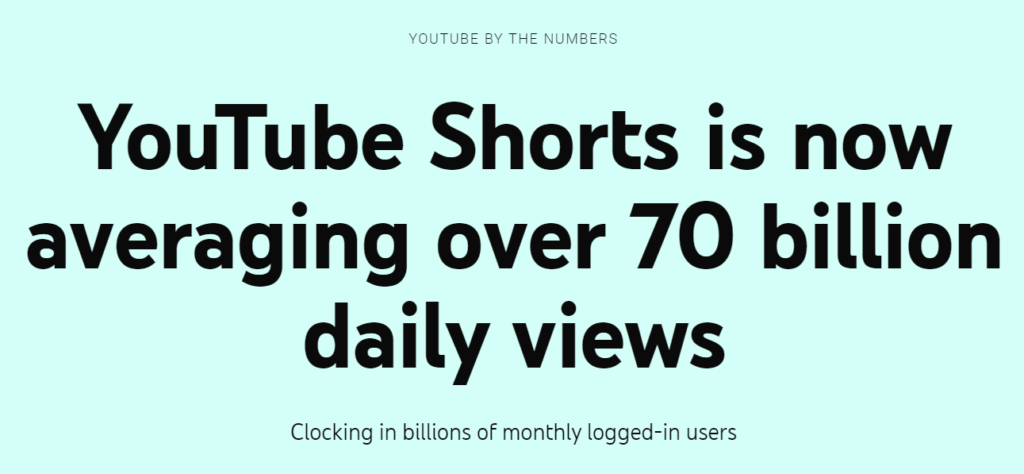
#13 People watch more YouTube on their TVs than watch Netflix.
People are watching YouTube on their TVs 80 percent more than pre-covid numbers. Over 94 percent of consumers who stream services to their TVs watch YouTube, compared to 75 percent of those who stream Netflix.
And we’re spending more than 40 minutes each session watching content on our mobile devices, too. The platform is steadily spreading throughout our lives to become one of our main sources of video content. When it comes to YouTube statistics, this is an impressive one. In fact…
#14 The data says YouTube is currently outperforming Netflix, Disney Plus, and Prime Video.
Yeah. YouTube has more users than each of those streaming services, and YouTubers spend more time watching video content on the platform than they do watching video on Netflix, Disney Plus, or Prime Video. In my Elon voice, “Hey, Bob!”
Surely, I’m not the only one who has fallen into a recommendation-video-fueled rabbit hole and lost (or invested depending on how you look at it) HOURS to a random, yet interesting, parade of YouTube videos. People are watching more than one billion hours of YouTube videos every day. That’s more than Netflix and Facebook combined
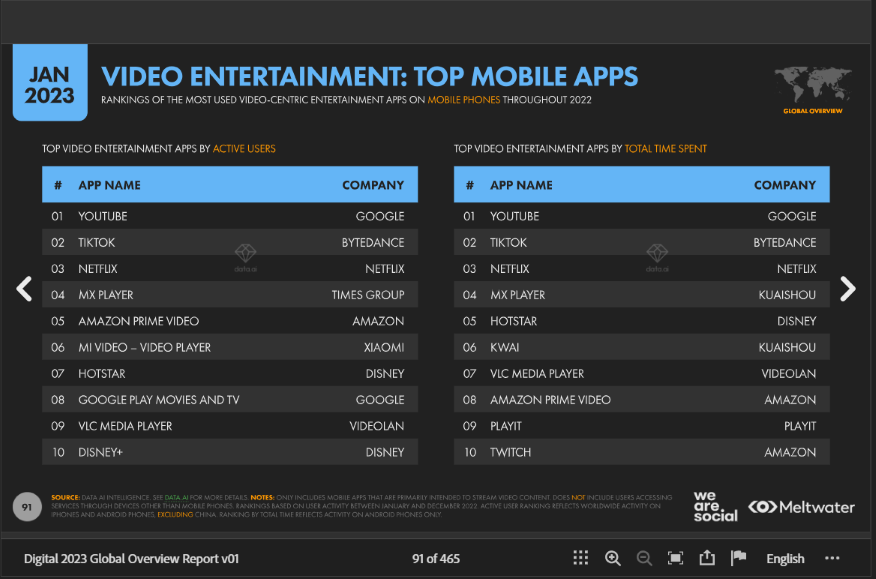
#15 Nearly a quarter of the time people are watching video is now spent viewing live content.
Live streams have become an integral part of the digital environment allowing people to leverage different content formats across platforms to meet different content needs. Live video became a huge deal during the pandemic, and it’s still a staple personally and professionally:
- 42% of people in the US say they’ve watched a live stream
- 40% of marketing execs say they expect to attend work-related conferences and events that are completely virtual
- 52% of live video viewers stream live content via social media networks
- 39% of YouTubers regularly watch live streams
#16 79% of people say they achieve deeper connections when they watch YouTube TV.
YouTube lends itself well to community building. A few years ago, the idea of virtual presence became a thing — just knowing other people are participating in the same activity. This is true even if the only way of knowing others are participating is by the view counter and the stream of comments on the right side of the screen. It’s sufficient enough to make people feel closer and more connected to one another.
Case in point…
When I grabbed this video embed 👇🏼, 38K people were tuned in to the live stream. At 1:33 PM on a random Wednesday.
YouTube’s Trends Report talks a bit about this: the community that vibed around Lofi Girl’s lofi hiphop channel helped pave the way for a Lofi Girl synthwave channel to be introduced to much anticipation by leveraging YouTube’s Community tab.
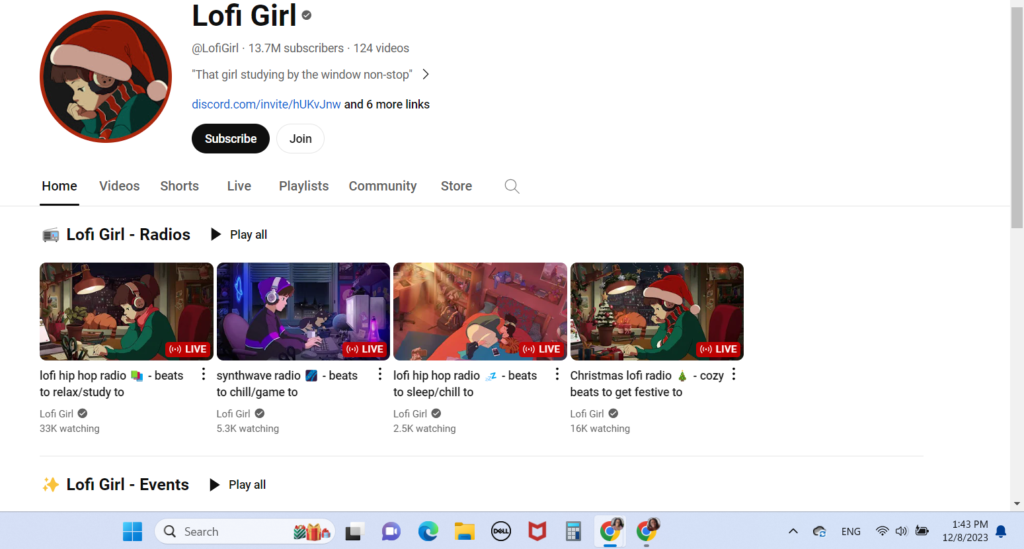
The creators of Lofi Girl have built a virtual community around the age-old idea of a study group. And that community engages on YouTube and Discord.
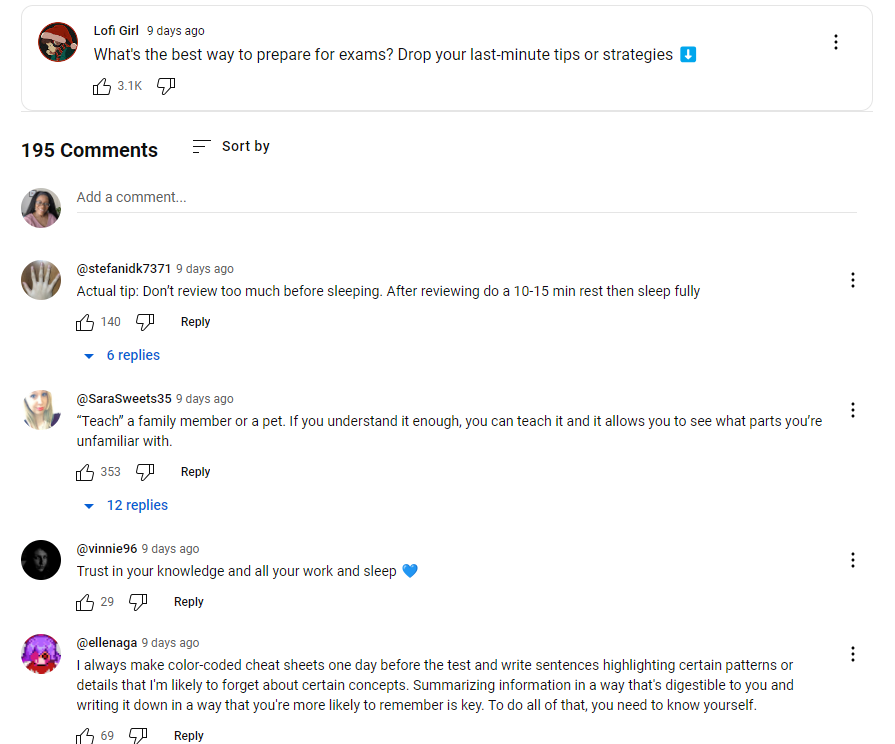
#17 Watching YouTube is considered time well spent.
76 percent of YouTubers agree the platform’s the best place to get a variety of opinions on a topic. It gives users the chance to conduct simple searches to find the content they want to watch, and provides a pretty good catalog of thoughtful perspectives and in-depth commentary. That’s according to data published by Think With Google.
Nearly 7 in 10 YouTubers (69 percent) have gone on a deep dive into a movie, music, or fan theory on YouTube. And believe it or not, 54 percent of those surveyed say they would rather watch YouTube creators break down a major event rather than watch the event itself.
I happen to be an MCU buff, but I never read comic books growing up. So, every superhero movie I watch is just a big surprise to me. “Holy crap! Is Howard Tony’s dad?” Actual quote. I’ve found that an important part of my experience connecting with the massive community of Marvel fans — many of whom watch all the things and read all the comics — is watching Easter egg videos on YouTube to help me understand what the heck I just watched, and to infuse the appropriate amount of excitement and anticipation into my experience ahead of Marvel’s new movies and shows. Most of my Marvel knowledge (and I have A LOT of it) I actually gleaned from watching content created by other MCU fans on YouTube.

Super important. Channels like New Rockstars help me decode the significance of events that transpire in the MCU and imbue me with all kinds of geek knowledge about the mythos and ethos of superhero fandom. It’s my version of filling my wine tumbler with fermented goodness.
Coincidentally, superhero movie fans — we’re the most likely fan group to watch livestreams on YouTube.
#18 Young adults lean into YouTube to help them achieve or enjoy different moods.
YouTubers — especially younger users — leverage the platform to help them find the right content for whatever mood they’re in.
- 83% of young YouTubers have used the platform to watch soothing content that helps them relax and cope
- 90% say they have watched a video that helped them feel like they were in a different place
- 53% say they like watching online horror content
YouTube Statistics: Its Effectiveness As a Marketing Channel
#19 70% of the content people watch on YouTube are recommendations from YouTube.
YouTube’s algorithm is STELLAR when it comes to matching user behavior with the types of content they are most likely to find interesting. The beauty of this is it nicely positions brands to be found by their audience when these brands invest in YouTube influencer marketing. Just sayin’.
#20 YouTube is a MAJOR product discovery source for users.
It’s not going to be super shocking to learn that 90 percent of YouTubers say they discover new brands or products when they watch YouTube videos.
Case in point: I started seeing Baerskin Hoodie ads a few months ago. Yeah… no, none of these people are African American moms like me… but then I watch A LOT of content about sci-fi and action movies, off-grid living, and surviving the Northern Territories. So, I get why I’m seeing the ads. To the algorithm, I’m sure my watch habits overlap the watch habits of someone who would be into this product. And the targeting was spot-on. I’m ordering these for myself and my daughters. And I recently found out my dad – who hunts, fishes, and works outdoors – owns Baerskin hoodies.
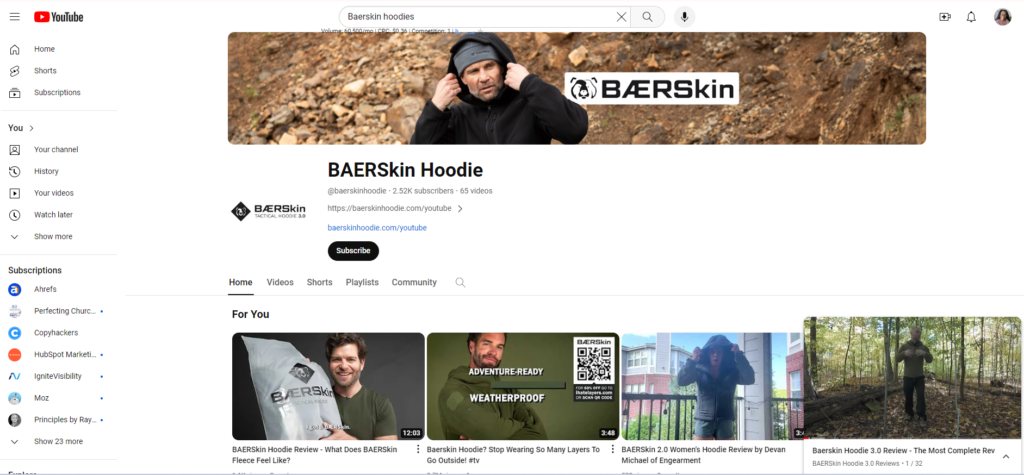
#21 70% of people say they bought a brand after seeing it on YouTube.
Now, compare that to the 40 percent of users who said they had purchased something after seeing it on YouTube just a few years ago. That’s a pretty big jump.
#22 Video ads get 3X the eyes of regular TV ads.
This is important because people are 3X more likely to pay attention to online video ads over television ads. They are twice as likely to give their attention to a YouTube video ad, even over Instagram and Facebook video ads. No doubt that has a lot to do with the platform’s targeting capabilities.
#23 YouTube ranks 3rd with marketers as a preferred social media marketing channel.
Facebook has been the leader in social media marketing since forever. And Instagram is the primary platform for influencer marketing efforts. YouTube occupies a sweet spot that more than half of marketers say makes it worth leveraging. In fact, according to The State of Marketing 2023, a report released by HubSpot, 57 percent of marketers were leveraging YouTube as part of their marketing strategy. Because these are the type of YouTube statistics they know how to leverage.

#24 YouTube also ranks 3rd with marketers for social media platforms that offer the highest ROI.
Brands and marketers continue to allocate resources to YouTube marketing. YouTube ranked third among influencer marketers for most popular platforms and third as the social media platform that offers the highest ROI when selling products directly in the app, according to HubSpot’s 2023 Global Social Media Trends Report.

2024 YouTube Statistics in Conclusion
I’m sure this isn’t the first time you’ve seen a marketer acting like video is the only strategy out there. YouTube probably isn’t the only channel that comes to mind when video marketing is mentioned, but it’s a pretty effective one for running influencer campaigns, amplifying reach, and diversifying the content of your multichannel marketing push.
Facebook, Instagram, Snapchat, and LinkedIn all have video features that can breathe new life into repurposed content and pivot your brand from being a name in the network to being a human-centered collective of professionals that other organizations know, respect, and admire.
Take these YouTube statistics as proof. The platform can add a touch of mid-funnel magic to the sales cycles of marketers and brands. It allows for creative, high-impact storytelling that your team can personalize AND scale.
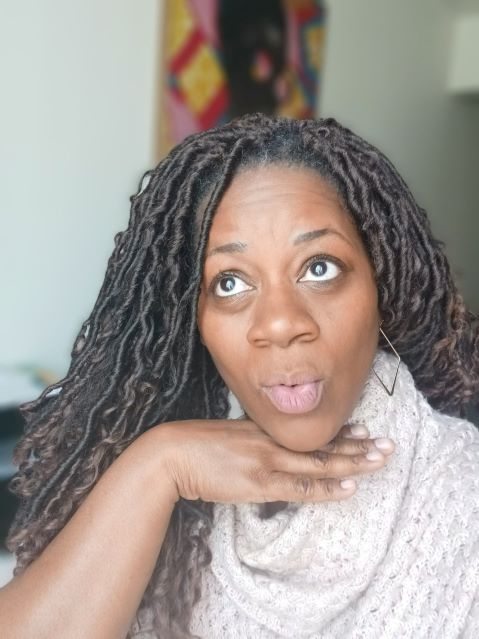
About the Author
Sorilbran Stone | Content Strategist
I serve as the resident content strategist and the official Head of Content Marketing at The Shelf. Marketing is my happy place. I’m as happy looking at analytics as I am actually creating a thing. I focus a lot on dreaming up and implementing the best ways to create, publish, and distribute content that will builds our brand and gets our readers to do a thing


